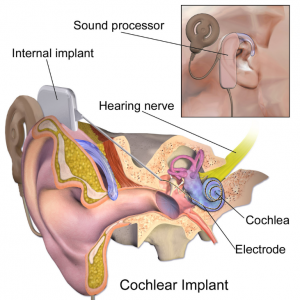FISO’s miniature sensors used in otology
February 04 2021
Did you know that FISO’s fiber optic pressure sensors helped scientists to better develop cochlear implant technology? Such electronic medical devices partially restore hearing by delivering sound signals directly to the auditory nerve through an electrode implanted in the internal ear (into the cochlea). With its miniature size (OD < 300 µm) FISO’s pressure sensor can be positioned in the tiny ducts of the internal ear (such as scala vestibuli and scala tempori) to allow in situ intracochlear measurements of sound pressures thanks to the sensor’s incredibly high sensitivity [1], [2],[3]. FISO’s fiber optic sensors have also been used to help improve the functional atraumatic insertion of cochlear implants [4], [5] and are even integrated into middle-ear surgery tools such as PalpEar [6] where oriented force feedback is given to the surgeon. Contact FISO for more details on this unique sensing technology.

[1] Mattingly et al. “Effect of Skin Thickness on Cochlear Input Signal using Transcutaneous Bone Conduction Implants” Otology & Neurotology (2015) 36(8) pp. 1403-1411
[2] Greene et al. “Cochlear Implant Electrode Effect on Sound Energy Transfer within the Cochlea during Acoustic Stimulation” Otology & Neurotology (2015) 36(9) pp. 1554-1561
[3] Borgers et al. “Intracochlear Pressure Measurements to Study Bone Conduction Transmission: State-of-the art and Proof of Concept of the Experimental Procedure” AIP Conference Proceedings (2018) 1965, 050005; doi: 10.1063/1.5038471
[4] Todt et al. “Effect of Different Insertion Techniques of a Cochlear Implant Electrode on the Intracochlear Pressure” Audiology & Neurotology (2016) 21 pp. 30-37
[5] Todt et al. “Effect of Round Window Opening Size and Moisturized Electrodes on Intracochlear Pressure Related to the Insertion of a Cochlear Implant Electrode” Audiology & Neurotology Extra (2016) 6 pp. 1-8
[6] See video by clicking here : Palpear



